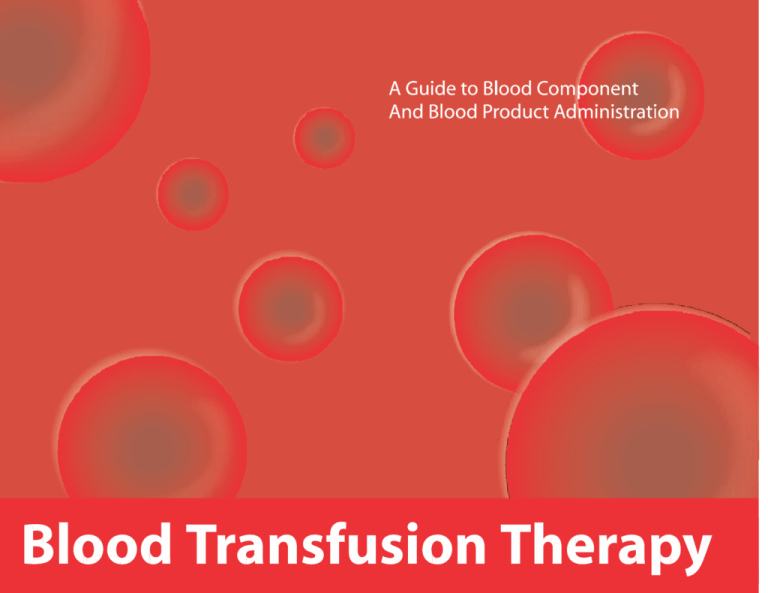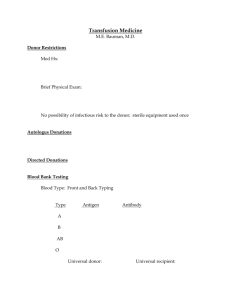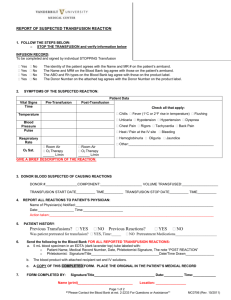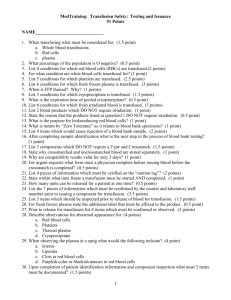Guide to Blood Component and Blood Product Administration
advertisement

Blood Transfusion Therapy: A Guide to Blood Component and Blood Product Administration, February 2015 1 Nova Scotia Provincial Blood Coordinating Program Room 7 -130 Centennial Building 1276 South Park Street Halifax, NS B3H 2Y9 Phone: (902) 473 - 8207 Fax: (902) 473 -2589 Email: nspbcp@cdha.nshealth.ca Website: http://novascotia.ca/dhw/nspbcp/ The production of this Guide to Blood Component and Blood Product Administration has been made possible through a financial contribution from the Public Health Agency of Canada. Blood Transfusion Therapy: A Guide to Blood Component and Blood Product Administration, February 2015 2 Definitions ABO & Rh Testing patients’ red cells and plasma/serum to identify ABO blood type and Rh (D) blood type. Antibody Screen Testing the patients’ serum for allo-and/or auto-antibodies usually developed after exposure to foreign red cells or during pregnancy. Antibody Investigation Extensive testing of the patients’ serum to determine the presence of new and/or reconfirm previously identified antibodies known to cause transfusion reactions. Blood Components A therapeutic component of blood intended for transfusion (eg. red cells, granulocytes, platelets, plasma) that can be prepared using the equipment and techniques available in a blood centre. BTS- Blood Transfusion Service – Blood bank. DAT-Direct Antiglobulin Test Testing of patient red cells to determine if they are coated with antibody or complement. Used in the investigation of adverse events, autoimmune hemolytic anemia, drug induced hemolysis, hemolytic disease of the newborn, and alloimmune reaction to recent transfusion. Group & Screen/Type & Screen Testing performed on a patient’s blood sample which includes ABO & Rh and antibody screen. Blood Products Any therapeutic product, derived from human blood or plasma, and produced by a manufacturing process that pools multiple units. Also may be referred to as plasma derivatives. Serological Crossmatch Testing of the patient’s serum with donor red cells to determine compatibility. General Transfusion Practices COMPATIBILITY TESTING Crossmatching should be performed for all red cell components. Type and screen should be ordered if transfusion is possible but unlikely. Type and crossmatch MUST be ordered if transfusion is likely. STORAGE TEMPERATURE Blood components and blood products are stored according to facility temperature and storage device policies therefore refer to facility policy to identify these requirements. In order for blood components or blood products to be re-issued from BTS, unused products must be returned to BTS within 30 minutes of dispensing and BTS will determine whether the blood components/blood products can be safely returned to inventory or discarded. CAUTION: Do not store blood in an unmonitored refrigerator. PRE -TRANSFUSION Verify physician’s order. Verify that consent was obtained. Provide transfusion pamphlet information for patient. Verify patient and blood unit identification. Verify special product requirements. Blood Transfusion Therapy: A Guide to Blood Component and Blood Product Administration, February 2015 3 DOCUMENTATION AND MONITORING 1. Document vital sign intervals within 1 hour prior to administration, minimum of 15 minutes after starting, hourly until transfusion completed and 20-60 minutes following completion of transfusion. (as per facility policy) 2. Document bedside verification process. 3. Monitor patient during and after transfusion for signs of an adverse transfusion reaction and document. 4. Document volume administered and transfusion reaction as per facility policy. 5. Complete patient notification process (as per facility policy). FILTERS Filter all blood components through a standard (170-260 micron) blood filter. COMPATIBLE INTRAVENOUS SOLUTIONS 0.9% NaCl solutions DO NOT use Dextrose solutions (may induce hemolysis) (exception: IVIg infusion). DO NOT use Lactated Ringer’s (may induce clot formation in the blood bag and/or administration set). TIME OF INFUSION Blood components or blood products must be infused within 4 hours of dispensing from BTS. Before ordering blood components from BTS ensure your patient is ready for transfusion: i.e. consent obtained, IV patent. Blood products may require special infusion sets. If an unexpected delay in starting the transfusion, return unused blood components or blood products immediately to the BTS to allow them to determine if it can be safely returned to inventory or discarded. MEDICATION WARMING CAUTION! Medication must not be added to or piggy-backed with any blood/blood component or plasma derivative. If warming is needed, a calibrated blood warming device must be used to ensure the blood is not warmed to a temperature at which red cell hemolysis occurs. (less than 42°C). Refer to transplantation or nursing protocol for infusion of HPCs (stem cells). PUMPS Refer to facility policy and specific blood components/product. Physicians order required. Blood Transfusion Therapy: A Guide to Blood Component and Blood Product Administration, February 2015 4 Red Cell Components ABO/Rh COMPATIBILITY Red cell ABO group and Rh specific components are preferred (1st Option); however ABO group and Rh compatible red cells are acceptable (2nd Option). STORAGE TEMPERATURE Red cells are stored in a controlled BTS refrigerator between 1- 6ºC. FILTERS ALL red cell components must be administered through a standard (170-260 micron) blood filter. TIME OF INFUSION Components must be infused within 4 hours of dispensing from BTS. Patient ABO Group Donor Group 1st Option A B AB O A B AB O Donor Group 2nd Option O O A, B, O — Patient Rh Donor Rh 1st Option Donor Rh 2nd Option Positive Negative Positive Negative Negative Positive* MEDICATION DO NOT add, piggyback or push medication with red cell components. COMPATIBLE INTRAVENOUS SOLUTIONS 0.9% NaCl injection. PUMPS Acceptable for use. (Males and women of non-child bearing age) *Refer to facility policy BUFFY COAT SPIKING TECHNIQUE Do not over- spike the bags. Over-spiking will result in inability to remove the infusion set. Always insert/remove the infusion set using one quarter turn motions. Insert with clockwise one quarter turn twists and remove with counter clockwise one quarter turn twists. Do not twist in both directions while spiking or unspiking. Pulling the spike out in a straight downward motion will result in the tightening of the port on the spike. Blood Transfusion Therapy: A Guide to Blood Component and Blood Product Administration, February 2015 5 Platelet ABO Selection Chart Platelets Patient ABO Group ABO COMPATIBILITY For platelets, ABO specific transfusion is preferable but not required. The donor plasma in platelet components should be ABO compatible with the recipient’s red cells when possible. In cases where ABO specific platelets (1st Option) are not available, it is recommended that platelets are selected in the order listed in the Platelet ABO Selection Chart (2nd Option) COMPATIBILITY TESTING ABO identification of recipient required. STORAGE TEMPERATURE 20-24°C (room temperature). DO NOT REFRIGERATE PLATELETS. FILTERS ALL platelets must be administered through a standard (170-260 micron) blood filter. Donor ABO Specific Donor non -ABO Specific (1st Option) (2nd Option) Selection Order A A AB, B, O B B AB, A, O AB AB A, B, O O O A, B, AB TIME OF INFUSION Should administer as rapidly as patient can tolerate (20 min. adult average). Must be infused within four hours of dispensing from BTS. MEDICATION DO NOT add piggyback or push medication with platelet concentrates. PUMPS Infusion device NOT recommended. Rh COMPATIBILITY Rh-negative platelet concentrates can be given to Rh-positive patients. If Rh-positive platelet concentrates are given to Rh-negative patients, the use of Rh Immune Globulin (Anti-D) should be given to women of child-bearing age and considered for women (greater than 50 years of age), and men. Refer to facility policy. Type Volume Usual Dose Platelets apheresis, leukocytes reduced (single donor) 150-400 mL 1 unit equals approximately 1 pooled Buffy Coat unit CP2D Platelets, leukocytes reduced (random donor) 40-70 mL each 1 unit/10 kg body weight CPD Platelets, pooled, leukocytes reduced (Buffy Coat) (multiple donors) Approx. 300 mL 1 adult dose* bag contains 4 group matched donors (pooled at CBS) Red Cell Components and Platelets Blood Transfusion Therapy: A Guide to Blood Component and Blood Product Administration, February 2015 6 Plasma and Cryoprecipitate COMPATIBILITY TESTING ABO identification of recipient required. STORAGE TEMPERATURE Plasma and cryoprecipitate are stored frozen at less than or equal to -18°C. TYPES OF COMPONENTS Requires about 30 - 60 minutes to prepare for use. Type Volume/Unit Plasma (FFP Apheresis) (FP) 100- 600 mL Cryosupernatant Plasma (CSP) greater than or equal to 100 mL Cryoprecipitate (CRYO) 5-15 mL Multiple units of cryoprecipitate may be mixed together (pooled). Transfuse within four hours of dispensing. FILTERS Plasma and cryoprecipitate must be administered through a blood filter (170-260 micron). COMPATIBILITY ABO Plasma components must be ABO compatible. Cryoprecipitate does not require ABO compatibility for adult transfusions. Patient ABO Group Donor Group 1st Option Donor Group 2nd Option A A AB B B AB AB AB - O O A, B, AB TIME OF INFUSION Must be infused within 4 hours as rapidly as clinically tolerated and as specified by ordering physician. MEDICATION DO NOT add, push or piggyback medication with plasma or cryoprecipitate. PUMPS Acceptable for use. Rh Plasma and cryoprecipitate may be transfused without regard to Rh type. Blood Transfusion Therapy: A Guide to Blood Component and Blood Product Administration, February 2015 7 Blood Products EXAMPLES OF BLOOD PRODUCTS (Note: this is not a comprehensive list) Albumin (5%, 25%) Intravenous Immune globulin (IVIg) Factor VIII concentrates (some are recombinant) Factor IX concentrates (some are recombinant) Factor VIIa concentrate (recombinant) TIME OF INFUSION Must be infused as specified by manufacturer’s instructions or within 4 hours of dispensing from BTS. Coagulation concentrates should be transfused immediately after reconstitution and as rapidly as patient can tolerate. For IVIG initial and maximum rate of infusion and IVIG administration guidelines please refer to: Anti-inhibitor coagulation complex (indicated for patients with high-titre Factor VIII inhibitors) http://gov.ns.ca/health/nspbcp/professionals.asp Rh Immune Globulin (for IM and IV use) DO NOT add, push or piggyback medication with blood products. MEDICATION COMPATIBILITY TESTING COMPATIBLE IV SOLUTIONS Crossmatching not required. Refer to manufacturer’s instructions For blood product specific information, please refer to: FILTERS http://gov.ns.ca/health/nspbcp/professionals.asp For coagulation factor concentrates, filtration using a standard blood filter or the filter supplied with concentrates is required. PUMPS Acceptable for use. Albumin, plasma protein fraction, and serum globulins do not often require filtration but may require special infusion sets (i.e. Albumin and IVIg require vented sets). Follow manufacturer’s instructions. Blood Transfusion Therapy: A Guide to Blood Component and Blood Product Administration, February 2015 8 Blood Blood Transfusion Therapy: A Guide to Blood Component and Blood Product Administration, February 2015 9 STANDARD TRANSFUSION VOLUMES FOR INFANTS AND SMALL CHILDREN TIME OF INFUSION Must be infused within 4 hours of dispensing. The rate of infusion depends on clinical condition/size of patient, amount to be infused, product being infused and physicians order. IV CONSIDERATIONS Red blood Cells are usually infused through an 18 gauge cannula to provide optimal flow and prevent hemolysis. Smaller gauge cannulas can be used for neonates, infants and children. A 22 gauge is often used for children. Red cells can safely be administered through 23 - 25 gauge cannulas, however the rate will be slower. FILTERS Filters for the pediatric population follow the same standard of 170 - 260 microns for blood components. Component Volume Estimated Change Red Blood Cells 10 to 15 mL/kg Hgb↑ 20 to 30 gm/L Platelets 10 mL/kg ↑15-25 x 109/L Plasma 10 to 2 0 mL/kg Factor activity ↑15% to 20% Cryoprecipitate 1 unit/ 10 kg Fibrinogen ↑to 0.5 g/L For further information about product and dosing the physician can contact the Hematologist on call through the IWK switchboard (902) 470-8888 For transfusion administration inquiries, contact Transfusion Medicine Nurse for the IWK Health Centre (902) 470-6531. Blood Transfusion Therapy: A Guide to Blood Component and Blood Product Administration, February 2015 10








